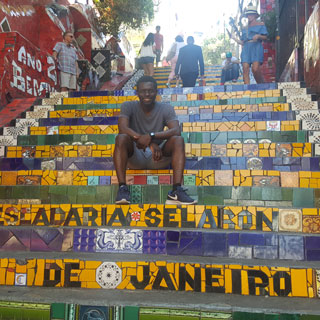Brazil: An Amazing Taste of South America


by Bright Botchway, MBA ’19
“Obrigado” and football facts were the two main things I armed myself with as I set off for Brazil from Paris to join my colleagues for an international trek. I was unprepared for the amazing cultural, social and corporate experiences I would encounter.
Brazil is Latin America’s largest economy, with a GDP of $1.8 trillion in 2016.* It was one of the world’s fastest-growing emerging markets in the first decade of the new millennium. With a population of 206 million and GDP per capita of $8,649 in 2016, Brazil is firmly an upper middle-income country and a member of BRICS (the association of five major emerging national economies or Brazil, Russia, India, China and South Africa). It is particularly strong in agriculture and is the world’s largest producer/exporter of sugar, coffee, orange juice, and beef, among a host of other commodities and essential foods.
The country endured several political crises, (a former president impeached, another in jail and the current president accused of corruption), yet it continues to be an economic global powerhouse. Foreign direct investment (FDI) significantly increased in 2016 and 2017, with GDP moving from recession levels of -3.5% in 2015 to 3% expected growth in 2018. Notably, average GDP growth was only 0.98% from 2010 to 2015. In addition, seven Brazilian companies are now on the Fortune Global 500 list—Itaú Unibanco, Petrobras, Banco Bradesco, Banco do Brasil, Vale, JBS, and Ultrapar.
My interest in Brazil from a business and cultural perspective was piqued when I took two courses with Senior Lecturer Lourdes Casanova: Leaders in Emerging Markets as well as Competition from Emerging Markets. It was insightful to obtain an insider view about the Brazilian business environment in class and then visit companies I had studied. These companies and institutions included Natura, Rock in Rio, São Paulo Mayor’s Office, Nubank, Itaú Unibanco and Petrobras.
Many of the companies had a serious focus on sustainability. Natura, a cosmetic company, has become a world leader in the industry with its sustainable practices, including helping Amazonian communities sustainably source plant species used in cosmetics. In addition, Natura’s manufacturing plant on the outskirts of São Paulo utilizes almost entirely natural lighting due to the architectural design of the building. The company also planted a forest next to its manufacturing plant, does not animal perform testing, and has a neutral carbon footprint. I thought their record of accomplishment was outstanding given that manufacturing plants are often windowless, stuffy, polluting places.
On the other hand, Petrobras, a state-owned enterprise (SOE) and the largest oil and gas company in Brazil was mired in a corruption scandal that led to the impeachment of President Dilma Rousseff. The company also played a significant role in the corruption charges that led to the incarceration of President Lula da Silva. In 2014, Petrobras plunged to a $21.6 billion reals net loss and Moody’s downgraded the company to the lowest possible speculative level.
Petrobras has since appointed a new chief executive officer, Pedro Parente, separated the role of Chairman from CEO, and created a new board that has significant corporate experience and are not political appointees. In 2016, Petrobras generated an operating profit of $17 billion reals and in April 2017, Moody’s upgraded Petrobras’ credit rating from B2 to B1 and changed its outlook to positive, indicating that the rating could be raised again any time. During the visit, the Head of Investor relations explained the strong corporate governance structures Petrobras created to ensure the past does not repeat itself
Even though São Paulo is a city, the 12 million-strong population make its administration feel as if one is running a country. When we visited, the São Paulo Mayor’s office showed us that they had implemented steps to enhance governance. In fact, the public mayor’s office was running itself as a profitable private institution. Several loss-making non-essential public services were in the process of privatization, including concert venues and a football stadium. Funds raised from the privatization will go to the Municipal Development Fund, which in turn will use the money to fund programs related to the mayor’s three main themes for the city: education, healthcare and housing.
To improve public wellbeing, the city opened many new bike paths and some major highways are even closed on Sundays for leisure. We had the chance to stroll the famous Paulista Avenue one Sunday evening to enjoy public music and dance.
We also visited two very different institutions in the same industry: Itaú UniBanco and Nubank.
Itaú Unibanco is Brazil’s biggest private bank, the largest financial conglomerate in the Southern hemisphere and the 10th-largest bank in the world by market value, with presence in 18 countries. It serves as a one-stop shop for commercial, retail and investment banking, has nearly 5,000 branches and recently shifted its focus on utilizing data improve customer service.
Nubank on the other hand was a fintech started in 2013 with no physical branches, offering credit cards to Brazilians without annual fees. In Brazil, credit card fees are among the highest in the world, with rates as high as 347%. Nubank was an instant hit; it immediately had 8 million credit card applications in the pipeline, made $800 million in profits, and looked to add deposit and investing services all on a single app.
Both banks were working to solve the same problems: providing credit at reasonable interest rates, making banking accessible to the unbanked, utilizing data to understand customer needs, and providing bespoke financial services.
Although not part of the official trek, it was interesting to follow former President Lula Da Silva’s Supreme Court appeal process occur in real time while we were in São Paulo and Rio. Despite the sensitivity of the issue, the public seemed calm on the surface as they went about their daily activities. The day before the Supreme Court justices made their decision public, thousands of Brazilian protesters participated in a peaceful march.
On the other hand, the stark difference between wealth and poverty was very apparent in the cities of São Paulo and Rio. São Paulo is home to many millionaires and the world’s largest private helicopter fleet, and yet there were many instances of visible extreme poverty including homelessness, petty theft and robbery. At least in my experience, people who stole did not intend to inflict physical harm but only grabbed what they needed to be able to fend for themselves and survive.
I could not write this without discussing the country’s wonderful culture. Brazil has some of the best food I have ever had: from churrasco, feijoada, cheese breads, and of course, bottomless caipirinhas. People we met were generally very friendly and once we made the effort to speak Portuguese, they welcomed us warmly. It was wonderful to know that an hour drive outside most cities and one would end up either on pristine beaches or in beautiful, serene forests.
Growing up as a soccer fan, I always dreamed of visiting Brazil for a football-related event. I did visit the Football Museum in São Paulo, however, the cultural, political and economic activities turned out to be the highlights of my trip. I look forward to exploring more of the country and South America in the future; I would like to continue learning about the business experiences and resources that enabled Latin American companies to build both regional giants and multinationals. It was just as insightful to learn about these companies’ failures as well as their successes, and these lessons will come in handy as I embark on my post-MBA career in Consulting in Africa. The connections made on the trip will serve me a lifetime.
Finally, I can meaningfully say “Obrigado, Brasil!”
*All data sources are from data.worldbank.org. Accessed 4-27-2018
